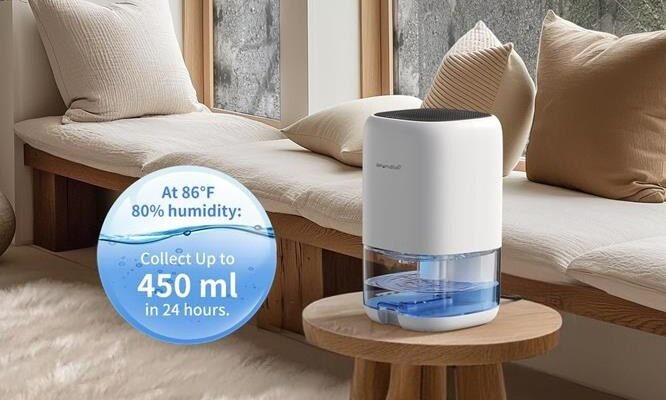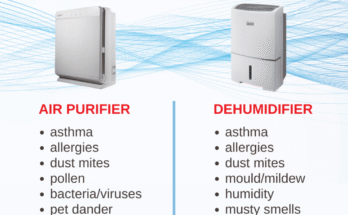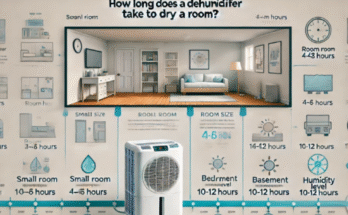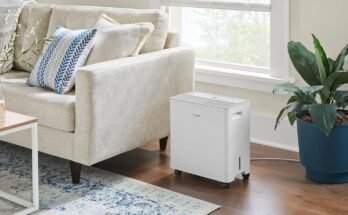Imagine walking into a room that feels sticky and uncomfortable, with dampness clinging to the air. You know that a dehumidifier is the answer, but you’re left wondering, “Where should I place a dehumidifier in a room?”
The right placement can make all the difference between a cozy, fresh space and a musty, uncomfortable environment. You’ll discover the secrets to positioning your dehumidifier perfectly, transforming your living space into a haven of comfort. Whether it’s for health, comfort, or simply wanting to protect your belongings, understanding the optimal spot for your dehumidifier is crucial.
Read on, and unlock the tips that will help you breathe easier and live better.

Ideal Room Locations
Finding the perfect spot for your dehumidifier can make all the difference in maintaining a comfortable and healthy environment in your room. The right placement ensures efficient moisture removal and helps prevent issues like mold and mildew. But where exactly should you put your dehumidifier? Let’s explore some ideal locations that could maximize its effectiveness.
Near Moisture Sources
Think about the areas in your room where moisture is most likely to accumulate. Is it the bathroom after a hot shower, or maybe the kitchen when you’re boiling pasta? Placing your dehumidifier close to these sources can swiftly tackle humidity levels before they spread throughout the room.
Consider your own daily routine. If you notice condensation on windows or damp towels in certain areas, these could be prime spots for your device. Tackling moisture at its source is a proactive approach that often yields the best results.
Central Room Placement
If you’re aiming for overall humidity control, a central location in the room can be highly effective. This allows the dehumidifier to circulate air evenly, addressing moisture from every angle.
Imagine your room as a circle, and place the dehumidifier at the center. This positioning can be particularly useful in larger spaces where moisture isn’t confined to a single area. You might find that this balance keeps the entire room feeling fresher and more comfortable.
Away From Walls And Furniture
It’s tempting to tuck your dehumidifier neatly against a wall or behind a piece of furniture. However, this can hinder air circulation and reduce efficiency. Aim for at least a few inches of space around the unit.
Think of your dehumidifier as needing room to breathe. This space allows air to flow freely and prevents the machine from overheating. With strategic placement, you can avoid unnecessary wear and tear and enjoy longer-lasting performance.
Where do you think would be the most effective spot for your dehumidifier in your room? Experiment with different placements and observe the changes. Personal experiences often lead to surprising insights, so trust your intuition and create a space that works best for you.
Factors To Consider
Placing a dehumidifier correctly enhances its efficiency. Knowing where to position it is crucial. Consider several factors when deciding the best spot in a room.
Room Size And Layout
Room size impacts dehumidifier performance. In small rooms, place it centrally. This ensures even moisture removal. Large rooms might need strategic placement. Position near moisture sources for better results.
Airflow And Circulation
Good airflow is key for a dehumidifier. Ensure it has space around it. Avoid placing it against walls. This restricts airflow. Open spaces improve circulation. It helps the dehumidifier work effectively.
Power Outlet Accessibility
Check for nearby power outlets. Long cords can be inconvenient. A close outlet is ideal. It reduces the risk of tripping over cords. Ensure the area is safe for electrical devices. Water and electricity don’t mix.
Common Mistakes
Placing a dehumidifier near walls or furniture can block airflow, reducing efficiency. Avoid positioning it close to heat sources, which may cause overheating. Keep it centrally located to ensure even moisture removal throughout the room.
Placing a dehumidifier in your room can be trickier than you might think. Many people make common mistakes that reduce the efficiency of their dehumidifiers. Have you ever wondered if you’re positioning yours correctly? Let’s dive into some frequent missteps and how to avoid them.
Placing In Corners
A common mistake is placing your dehumidifier in corners. While it might seem out of the way, corners actually hinder airflow. Think about it—corner placement traps the machine in a limited space, restricting its ability to circulate air effectively. Try positioning the dehumidifier in a more central location. It doesn’t have to be the room’s centerpiece, but a spot with unobstructed airflow can significantly boost its efficiency. Imagine how much better your room could feel with proper air circulation.
Blocking Air Vents
Blocking air vents with your dehumidifier is another frequent error. When vents are obstructed, air can’t move freely. This not only affects the dehumidifier’s performance but also impacts your room’s overall air quality. Ensure that no furniture or items block the air vents. A clear path allows the dehumidifier to pull in humid air and release dry air more effectively. A small change here can make a big difference in how comfortable your room feels.
Ignoring Humidity Levels
Ignoring humidity levels is a mistake you don’t want to make. Some people set up their dehumidifiers without checking the room’s humidity. But what if your room doesn’t need as much dehumidifying as you think? Use a hygrometer to measure the humidity before placing your dehumidifier. This can help you decide on the best placement and setting for your needs. Wouldn’t it be great to avoid unnecessary energy costs by knowing exactly what your room needs? Avoid these common mistakes to get the most out of your dehumidifier. A little attention to detail can go a long way in enhancing your home’s comfort and efficiency. Where are you placing yours?
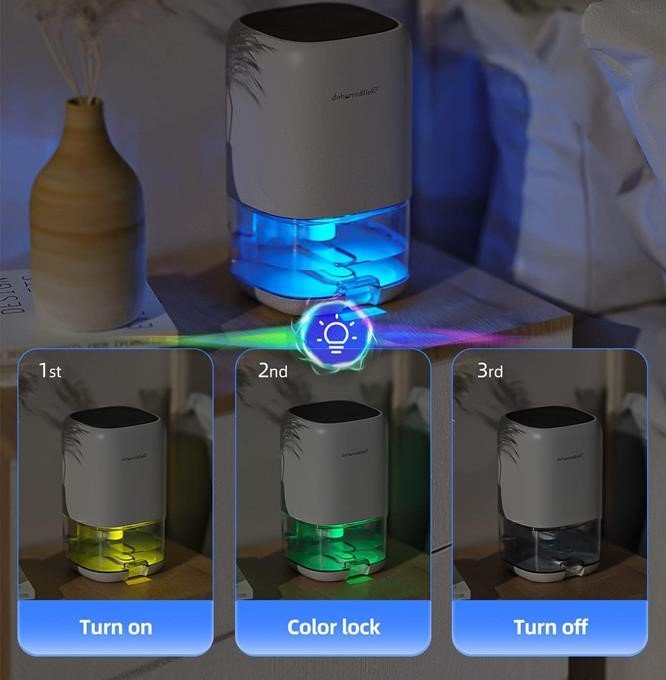
Optimizing Dehumidifier Efficiency
Placing a dehumidifier correctly maximizes its efficiency. A strategic location improves air flow. It ensures optimal moisture removal. For best results, avoid cluttered corners. Central placements in rooms work well. Ensure easy access for maintenance and adjustments.
Regular Maintenance
Regular maintenance keeps your dehumidifier running smoothly. Clean filters monthly. This prevents dust buildup. Check water collection tanks weekly. Empty them to avoid overflow. Inspect power cords for wear. Replace damaged cords immediately. These simple steps enhance performance.
Using Fans To Enhance Circulation
Fans help circulate air effectively. Place a fan near the dehumidifier. It pushes moisture-laden air towards it. Set the fan to low speed. This avoids disturbing the dehumidifier’s function. Ensure fans point away from walls. This maximizes room air circulation.
Adjusting Settings Based On Season
Seasons affect humidity levels. Adjust settings for efficient operation. In winter, lower the humidity setting. This reduces energy consumption. In summer, increase the setting slightly. It helps combat higher moisture levels. Regular adjustments ensure optimal conditions year-round.
Special Considerations For Specific Rooms
Positioning a dehumidifier near the center of a room ensures optimal air circulation. Avoid placing it against walls or corners to enhance moisture removal. Ensuring unobstructed airflow improves efficiency.
Placing a dehumidifier in the right spot is crucial. Each room has unique needs. Understanding these needs can boost your dehumidifier’s performance. Choose locations based on room type and function. This ensures maximum efficiency and comfort.
Basements And Crawl Spaces
Basements and crawl spaces often have high humidity. Place the dehumidifier centrally in these areas. It should be away from walls and corners. This placement allows air to flow freely. Check for any obstructions blocking the airflow. A clear path ensures effective moisture removal.
Bathrooms And Laundry Rooms
Bathrooms and laundry rooms generate a lot of moisture. Position the dehumidifier near the source of humidity. This could be near the shower or washer. Ensure it’s not too close to water sources. Keep it at least a few feet away to avoid water damage. Regularly empty the water reservoir for best results.
Living Rooms And Bedrooms
Living rooms and bedrooms need balanced humidity levels. Place the dehumidifier in a central location. Avoid spots near windows or doors. These areas might have fluctuating temperatures. A stable location offers consistent humidity control. Ensure the dehumidifier’s noise level suits your comfort, especially in bedrooms. `

Frequently Asked Questions
Where Not To Put A Dehumidifier In Bedroom?
Avoid placing a dehumidifier near walls, curtains, or furniture. Keep it away from heat sources or vents. Place it centrally for optimal air circulation. Ensure it’s not in a spot where it might tip over or obstruct pathways. Keep it away from electronic devices.
Where Is The Best Place To Put A Dehumidifier In A Room?
Place the dehumidifier centrally in the room for even air distribution. Ensure it’s away from walls or obstructions. Position it near moisture sources like windows or bathrooms for optimal performance. Maintain a safe distance from electrical devices for safety. Adjust settings based on humidity levels for efficiency.
Should Dehumidifiers Be Placed High Or Low?
Place dehumidifiers low to effectively capture rising damp air. Position it away from walls for optimal airflow. Ensure it’s near moisture sources like bathrooms or basements for best results. Regularly check and empty the water tank to maintain efficiency.
Should A Dehumidifier Be In The Basement Or Main Floor?
Place a dehumidifier in the basement if it’s damp and humid. It helps reduce moisture effectively. On the main floor, use it if you notice excess humidity or moisture issues. Choose the location based on humidity levels and specific needs.
Conclusion
Choosing the right spot for your dehumidifier matters. Place it centrally. Ensure good air circulation around it. Avoid corners or tight spaces. Keep it away from walls. Elevated surfaces can help. Monitor its performance. Adjust placement if needed. Consider room size and moisture levels.
Safety first—check electrical outlets. Regular maintenance keeps it efficient. Remember, a well-placed dehumidifier improves air quality. It makes your room more comfortable. Healthier. More pleasant. Your home deserves the best air possible. Follow these tips for optimal results. Enjoy a fresher environment.
Feel the difference. Live better.
